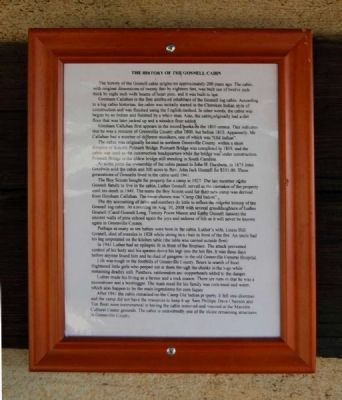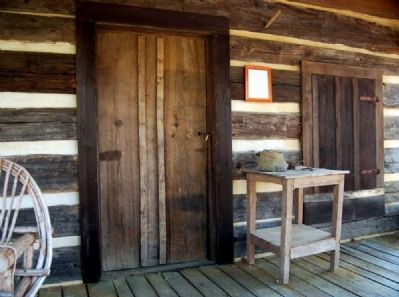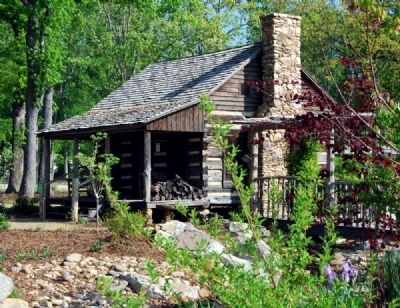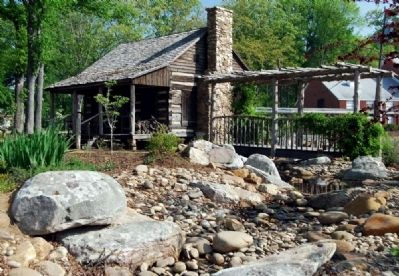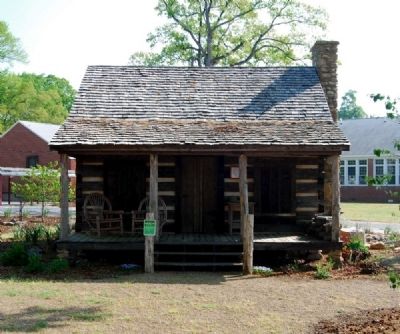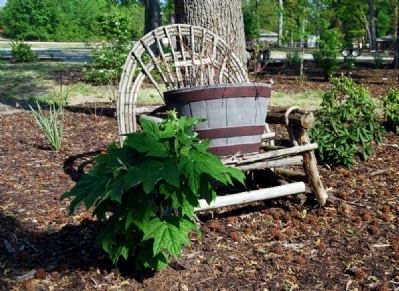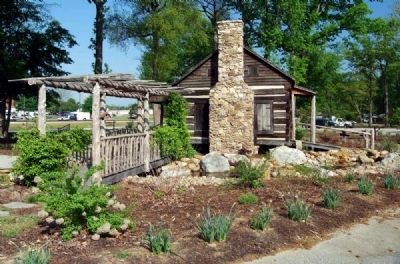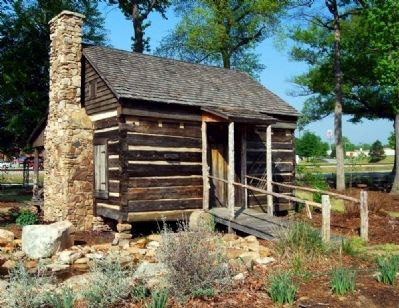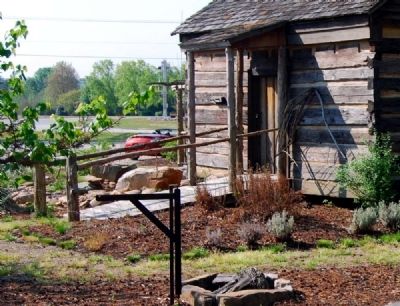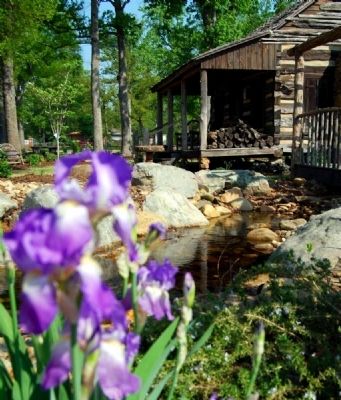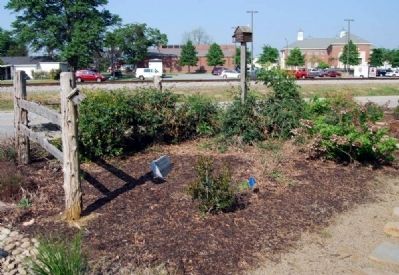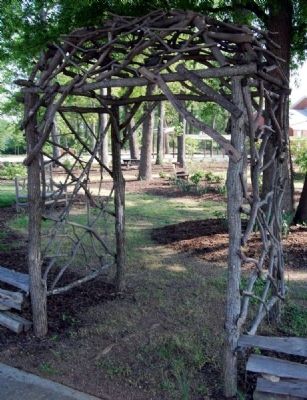Mauldin in Greenville County, South Carolina — The American South (South Atlantic)
The History of the Gosnell Cabin
The history of the Gosnell cabin originates 200 years ago. The cabin, with original dimensions of twenty-five by eighteen feet, was built out of twelve-inch thick by eight-inch wide beams of heart pine, and it was built to last.
Gresham Callahan is the first attributed inhabitants of the Gosnell log cabin. According to a log cabin historian, the cabin initially started in the Cherokee Indian style of construction and was finished using the English method. In other words, the cabin was begun by an Indian and finished by a white man. Also, the cabin originally had a dirt floor that was later jacked up and a wooden floor added.
Gresham Callahan first appeared in the record books on the 1810 census. This indicates that he was a resident of Greenville County after 1800, but before 1810. Apparently, Mr. Callahan had a number of different monikers, one of which was "Old Indian."
The cabin was originally located in northern Greenville County, within a short distance of historic Poinsett Bridge. Poinsett Bridge was completed in 1819, and the cabin was used as the construction headquarters while the bridge was under construction. Poinsett Bridge is the oldest bridge still standing in South Carolina.
At some point the ownership of the cabin passed to John H. Goodwin. In 1875 John Goodwin sold the cabin and 300 acres to Rev. John Jack Gosnell for $351.00. Three generations of Gosnells lived in the cabin until 1941.
The Boy Scouts bought the property for a camp in 1927. The last member of the Gosnell family to live in the cabin, Luther Gosnell, served as the caretaker of the property until his death in 1941. The name the Boy Scouts used for their new camp was derived from Gresham Callahan. The name chosen was "Camp Old Indian."
The dry accounting of dates and numbers do little to reflect the colorful history of the Gosnell log cabin. At a meeting on Aug. 10, 2008 with several granddaughters of Luther Gosnell (Carol Gosnell Long, Tammy Poore Mason and Kathy Gosnell Janson) the ancient walls of pine echoed again the joys and sadness of life as it will never be known again in Greenville County.
Perhaps as many as ten babies were born in the cabin. Luther's wife, Lizzie Dill Gosnell, died of measles in 1928 while sitting in a chair in front of the fire. An uncle had his leg amputated on the kitchen table (the table was carried out first).
In 1941 Luther has an epileptic fit in front of the fireplace. The attacked prevented control of his body and his spasms drove his legs into the hot fire. It was three days before anyone found him and he died of gangrene in the old Greenville General Hospital.
Life was tough in the foothills of Greenville County. Bears in search of food frightened little girls who peeped out at them through the chinks in the logs while remaining deathly still. Panthers, rattlesnakes and copperheads added to the danger.
Luther made his living as a farmer and a rock mason. There are rumors that he was a moonshiner and a bootlegger. The main meal for his family was corn meal and water, which also happen to be the main ingredients for corn liquor.
After 1941 the cabin remained on the Camp Old Indian property. It fell into disrepair and the camp did not have the resources to keep it up. Sam Phillips, Dave Chesson and Tim Brett were instrumental to having the cabin removed and restored at the Mauldin Cultural Center grounds. The cabin is undoubtedly one of the oldest remaining structures in Greenville County.
Erected 2009.
Topics. This historical marker is listed in these topic lists: Notable Buildings • Settlements & Settlers. A significant historical month for this entry is August 1861.
Location. 34° 46.767′ N, 82° 18.4′ W. Marker is in Mauldin, South Carolina, in Greenville County. Marker is at the intersection of Murray Drive and West Butler Road (County Route 107), on the left when traveling south on Murray Drive. Touch for map. Marker is at or near this postal address: 101 East Butler Road, Mauldin SC 29662, United States of America. Touch for directions.
Other nearby markers. At least 10 other markers are within 3 miles of this marker, measured as the crow flies. Mauldin United Methodist Church (within shouting distance of this marker); Mauldin (about 500 feet away, measured in a direct line); Laurel Creek Church (approx. 1.7 miles away); Bethel Community Training Ground (approx. 1.9 miles away); The Old Oak Tree (approx. 1.9 miles away); Bethel Church (approx. 2 miles away); Bethel Church Cemetery (approx. 2 miles away); The Old Arbor (approx. 2 miles away); Reedy River Factory (approx. 2.4 miles away); Lake Conestee in Transition (approx. 2.7 miles away). Touch for a list and map of all markers in Mauldin.
Also see . . .
1. Blog Article on the Gosnell Cabin. Another wonderful field trip – This time to the Mauldin Cultural Center and the Gosnell cabin. (Submitted on May 6, 2010, by Brian Scott of Anderson, South Carolina.)
2. Camp Old Indian. Official website of Camp Old Indian. (Submitted on May 6, 2010, by Brian Scott of Anderson, South Carolina.)
3. Mauldin Cultural Center. The Mauldin Cultural Center is home to numerous civic organizations including the Mauldin Chamber of Commerce, the Mauldin Rotary Club, the Garden Club of Mauldin, the Lion’s Club, Toastmasters, and the Disabled Veterans. (Submitted on May 6, 2010, by Brian Scott of Anderson, South Carolina.)
Additional commentary.
1. Gardener's Guide: Find Beauty, History at Cabin
by Durant Ashmore
July 2008
It is so very encouraging to see the spirit of volunteerism alive and well in the Golden Strip.
Even though we have beautiful scenery, beautiful climate and wonderful resources, it is truly the spirit of the people in our area that makes the Golden Strip such a special place to live.
The spirit is manifested by the work going on at the Mauldin Cultural Center. If you have driven by lately you have noticed the immense amount of work that has been undertaken there, in particular the garden that has been planted at the reconstructed 200-year-old cabin.
There are actually five different gardens located at the log cabin. These gardens are open to the public, and the public is encouraged to use them.
School groups, Boy and Girl Scout troops, garden clubs, church groups and anyone else who may want a picnic or a stroll are welcome.
The intention of the setting is to provide educational opportunities. Science and history are the dominate themes.
Each of the gardens contributes to this intention in various ways.
Located directly around the log cabin are native plants that our early pioneers would have encountered. Rhododendron, mountain laurel and deciduous azaleas abound. Hearts-a-bustin', native ferns, dogwood, serviceberry and heuchera add to this mix. This native plant arrangement has both scientific and historical implications.
The back of the log cabin will be an herb and physic garden. These gardens were an integral part of pioneer life.
When the pioneers needed seasoning for preparing and preserving foods, they were able to walk out the back door and make use of the different herbs growing in their garden.
The pioneers used their physic gardens in the same way. In these gardens they would grow medicinal plants and other plants for their daily use. They might grow broomsedge to make brooms with, daisy fleabane for insect control or foxglove (digitalis) for heart conditions.
In pioneer times, the pharmacies and grocery stores were located right outside the back door.
The vegetable garden at the log cabin is a further illustration of how the pioneers practiced self-sufficiency. For kids growing up in an urban setting, the log cabin vegetable garden may be a perfect illustration of a practice that is becoming less and less common.
Any school group that might wish to conduct experiments in growing is welcome to get involved with a project here. Also, you may want to plan a picnic at the time when the tomatoes are ripe. nothing is better than a tomato sandwich with tomatoes fresh off the vine.
The butterfly garden is an illustration of science in motion. Nectar plants, larval plants and host plants portray the life cycle of the butterfly from an egg to a caterpillar to a chrysalis to a beautiful adult butterfly.
The Carolina fence denotes all things Carolina. The state flower, the state stone, the state bird, the state wildflower and the state grass will all be represented. These features are highlighted by the use of a typical pioneer post and split-rail fence.
A rock garden is planted around the bubbling brook created on the site. Full sun plants that do well in this environment are utilized. Sedum (a great butterfly plant), iris, rose creek abelia (another butterfly plant) and creeping rosemary (an herb) are some of the plants used in this setting.
Today's column began by extolling the spirit of volunteerism here in the Golden Strip. In no way has this spirit been better exemplified than through the work of the Mauldin Garden Club.
The Mauldin City Council has been generous in providing seed money for this undertaking. The Mauldin Garden Club has taken this money and allowed this project to grow.
In fact, they have donated countless hours and $10,000 for the purpose of buying and installing hardscape items such as a bridge over the stream, a handicap ramp for the back entrance to the cabin and benches and arbors for the garden.
This project began with a vision that Bonnie Nisley, past president of the MGC, had several years ago. With her hard work and perseverance, it has come to fruition.
The entire city of Mauldin owes her a debt of gratitude.
— Submitted May 6, 2010, by Brian Scott of Anderson, South Carolina.
Credits. This page was last revised on May 22, 2022. It was originally submitted on May 6, 2010, by Brian Scott of Anderson, South Carolina. This page has been viewed 3,730 times since then and 222 times this year. Photos: 1, 2, 3, 4, 5, 6, 7, 8, 9, 10, 11, 12. submitted on May 6, 2010, by Brian Scott of Anderson, South Carolina.
